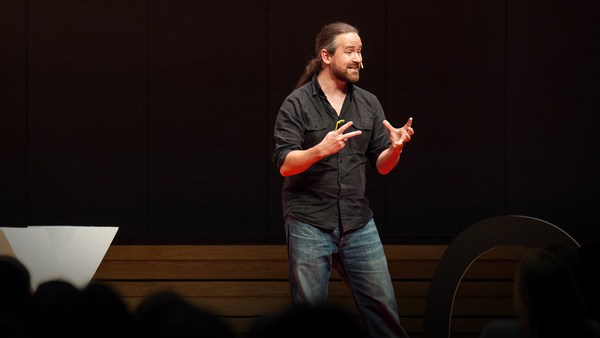For as long as I remember, I've loved mathematics. Actually, it's not 100 percent true. I've loved mathematics for all but a two-week period in senior high school.
(Laughter)
I was top of my class, and we were about to start the Extension Maths course. I was really excited about this brand new topic coming up, complex numbers. I like complex. My teacher was priming us for the concepts with some questions about square roots. Square of nine -- three; square of 256 -- sixteen. Too easy. Then she asked the trick question: What about the square root of negative one? Of course, we were all over it -- "Come on, Miss! We all know you can't take the square root of a negative." "That's true in the real world," she said. "But in the complex world, the square root of negative one is the imaginary number i."
(Laughter)
That day, my entire mathematical world came crashing down on me.
(Laughter)
"Imaginary numbers? Seriously? But mathematics is a source of truth, please don't go abstract on me. I would have studied art if I wanted to play with imaginary numbers."
(Laughter)
"This is Extension Maths, let's get back with our program!" She didn't, and over the next couple of weeks, I reluctantly performed meaningless calculations,
(Laughter)
finding imaginary solutions to quadratic equations.
(Laughter)
But then something amazing happened. We began finding elegant solutions to real-world problems we previously had no answers to, starting with the complex world of imaginary numbers. So some mathematician 500 years ago decides to have some fun and make up these imaginary numbers, and because of that we can now derive these amazing identities with applications in the real world, in fields like electrical engineering. Wow! I gained a whole new level of appreciation for mathematics. And after my brief mistrust, I was now in love with the subject more than ever.
Francis Su, the mathematician, sums it up beautifully when he says, "We study mathematics for play, for beauty, for truth, for justice and for love." But if you ask a student today, you'll probably hear a different story. You might hear "difficult" and "boring." And they might be right about difficult. But it's certainly not boring. In fact, I'd say being difficult to master is part of what makes it beautiful. Because nothing worth doing is easy.
So we need students to stick around long enough through the difficult parts to appreciate the beauty when it all ties together. Much like I did for that brief couple of weeks in high school. Unfortunately, our school systems -- we move students through mathematics in a lockstep process. So those who fall a little behind find it near impossible to ever catch up and appreciate that beauty.
But why is this a problem? Why should we care? Well today, more than ever, our world needs every citizen to be skilled in mathematics. With the advent of artificial intelligence and automation, many of the jobs we see today will either not exist or be transformed to require less routine work and more analysis and application of expertise. But we're not producing the extra mathematics students to fill these new roles.
This graph shows the number of students taking Standard Mathematics and Advanced Mathematics over a period of 20 years in Australia. It's clear that while we have demand for mathematics skills rapidly increasing, supply is in steady decline. To put things in perspective, half of the students completing high school today in Australia are not prepared to understand any argument about rates of change in data. In this digital age where fake news can influence election results, this is very concerning.
Let me give you a concrete example. Let's take a closer look at that graph. Can everyone see what I've done there to stress my point? If you can't, let me show you now, with the vertical axis starting at zero, where it should be. There, you see it now, right? It's the exact same data but I've manipulated the representation to influence you. And that's cool, that's my job up here.
(Laughter)
But in all seriousness, unless we do something to drastically improve student engagement with mathematics, we'll not only have a huge skills shortage crisis but a fickle population, easily manipulated by whoever can get the most air time. So what's the solution?
There are a lot of things we have to do. We need curriculum reform. We need our best and brightest encouraged to become teachers. We need to put an end to high-stakes tests and instead follow a mastery-based learning approach. But all these things take time. And I'm impatient.
See, I've been thinking about this for eight years now. Ever since I left my job as a derivative trader to build a web application to help students learn mathematics. Today, our app is used by schools across the globe. And we're seeing big improvements for students who use the program regularly. But here's the thing -- we're only seeing it for students who use the program regularly. And most of them don't. So after years of developing and refining the application, our biggest challenge was not so much product related, our biggest challenge was motivating students to want to work on their gaps in understanding. You can imagine in today's attention economy, we're competing against Facebook, Snapchat and PlayStation to try and get these students' time.
So we went back to the drawing board and started to think about how we could make it worthwhile for students to spend some of their "attention budget" on their education. We tinkered with gamification elements like points, badges and avatars, and we'd see a temporary spike in engagement but things would go back to normal as soon as the novelty wore off.
Then one day, my cofounder, Alvin, came across a study of students in Chicago led by the behavioral economist, Steven Levitt, where they paid students who improved on their test scores. He started telling me about some of the things they tested for and the interesting findings they had. For instance, they found that incentivizing students for inputs, like effort, worked a lot better than incentivizing for outputs, like test scores. They found that for younger students, you could win them over with a trophy but for older students, you really needed cash.
(Laughter)
And the amount of cash mattered -- 10 dollars was good, 20 dollars -- even better. But perhaps most importantly, they found that the rewards had to be instant rather than promised at a later date. They went as far as to give the students 20 dollars and say, "Touch it, feel it, smell it --"
(Sniffing)
"It's all yours. But if you fail, I'm going to take it back." And that worked really well. I immediately got excited about the possibilities of implementing this in our program. But once the excitement settled down, there were a few concerns that crept in our minds. Firstly, was this ethical?
(Laughter)
Secondly, how would we fund this thing?
(Laughter)
And finally, would the results be sustained if the students were no longer paid?
Now, let's look at the ethical part first. I'm a bit of a mathematical purist. So I'd be one of the first people to say that we should study mathematics for the sake of mathematics. Remember -- for play, for beauty, for truth, for justice and for love! Not for money!
(Laughter)
As I struggled with this, I came to see that, while it's a way I look at mathematics now, it's only because I studied it long enough to appreciate it. It's very difficult to tell a student struggling with mathematics today to work hard for a payoff in the distant future. And it's not so much bribery that's at work here, because I could bribe students by telling them about my big bonuses in my derivative trading days as a reward for doing well at maths. But it doesn't pay off for a very long time. So it's practically naught. Behavioral economists call this hyperbolic discounting. And Levitt goes as far as to say that all motivating power vanishes when rewards are handed out with a delay. So, from a purely economic point of view: if we don't use immediate incentives, we are underinvesting in student outcomes. I took heart from that, and came to see that as a society, we're actually quite used to financial incentives. Whether it be by the government, by employers or at home.
For instance, many parents would pay their children an allowance or pocket money for doing chores in the house. So it wasn't really all that controversial. As I thought about that, it started to answer that second question of how we were going to fund this. Naturally, parents are the most invested in their children's education. So, let's charge them a weekly subscription fee to use our program, but -- if the students complete their weekly maths goal, we'll refund the subscription amount directly into the child's bank account. We chose three exercises completed over a one week period for a 10 dollar reward. That way we're incentivizing effort rather than performance over a short enough period and with a substantial enough payout for the students to care.
Now, I remember when I first told my wife about this new business model. If she had any doubt left that I've gone completely mad, that pretty much confirmed it for her. She said to me, "Mo ... you realize that if everybody does their homework, which you want, you're not going to make any revenue, which you don't want. Great business model."
(Laughter)
I say it's more like an antibusiness model, it's free if you use it, but you pay if you don't. Now, I knew from experience that not everybody in the country was going to jump on and do their maths homework every week. And if they did, sure we'd go bust pretty quickly, but hey, we would have solved the country's maths skills crisis.
(Laughter)
As a company, we've always run a double bottom line, looking to both make a return for investors as well as improve student outcomes. We know that our path to long-term profitability is through improving student outcomes. So our dual objectives should never be at odds. So we're always looking to make our product decisions around helping students reach their weekly maths goal, effectively ensuring that they get paid and not us.
Now you must be wondering: How is this crazy business model going? You'll be glad to know we're still in business. We've been testing this now for the last five months on just our personal home users in Australia before we think about rolling it out to schools. And here are the early results. The green represents students who are completing their weekly maths goal and the red those who aren't. You can see a lot more completing their homework than not. In fact, as our user base has grown, we found the percentage to be pretty steady, at around 75 percent. So on average, we receive our weekly subscription fee once every four weeks, and the other three weeks, we're rewarding the students. Now of course we're leaving some money on the table here, but guess what? It turns out these students are 70 percent more engaged than students not on the reward program. Check.
From a business perspective, they are less likely to churn and more likely to refer friends, so we're hoping to trade off a lower revenue per user for a bigger and more engaged user base. Check and check.
Now for that final question. Would they keep coming back if they were no longer paid? Mathematics is so much more than just a subject you study at school. It's a human endeavor. It's what helps us to understand the world around us. And the more you know, the more you want to know. So yes, we've triggered initial engagement with a financial reward. But in the long run, the money won't matter anymore. Because in the long run, the wonder of mathematics will be the incentive and understanding it will be the reward.
Thank you.
(Applause)





